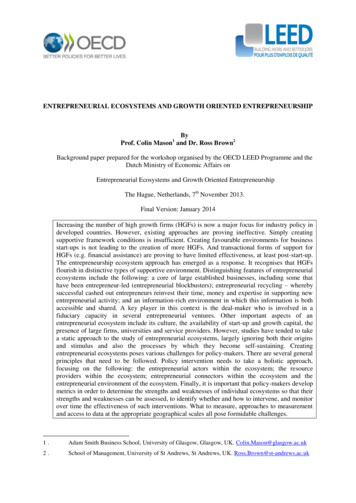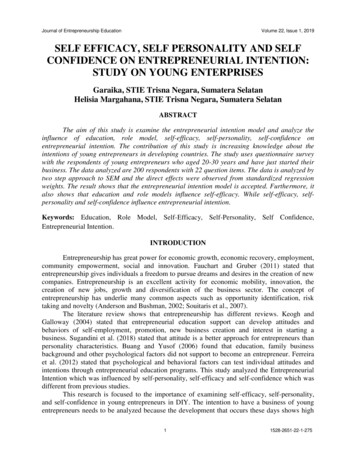
Transcription
ENTREPRENEURIAL ECOSYSTEMS AND GROWTH ORIENTED ENTREPRENEURSHIPByProf. Colin Mason1 and Dr. Ross Brown2Background paper prepared for the workshop organised by the OECD LEED Programme and theDutch Ministry of Economic Affairs onEntrepreneurial Ecosystems and Growth Oriented EntrepreneurshipThe Hague, Netherlands, 7th November 2013.Final Version: January 2014Increasing the number of high growth firms (HGFs) is now a major focus for industry policy indeveloped countries. However, existing approaches are proving ineffective. Simply creatingsupportive framework conditions is insufficient. Creating favourable environments for businessstart-ups is not leading to the creation of more HGFs. And transactional forms of support forHGFs (e.g. financial assistance) are proving to have limited effectiveness, at least post-start-up.The entrepreneurship ecosystem approach has emerged as a response. It recognises that HGFsflourish in distinctive types of supportive environment. Distinguishing features of entrepreneurialecosystems include the following: a core of large established businesses, including some thathave been entrepreneur-led (entrepreneurial blockbusters); entrepreneurial recycling – wherebysuccessful cashed out entrepreneurs reinvest their time, money and expertise in supporting newentrepreneurial activity; and an information-rich environment in which this information is bothaccessible and shared. A key player in this context is the deal-maker who is involved in afiduciary capacity in several entrepreneurial ventures. Other important aspects of anentrepreneurial ecosystem include its culture, the availability of start-up and growth capital, thepresence of large firms, universities and service providers. However, studies have tended to takea static approach to the study of entrepreneurial ecosystems, largely ignoring both their originsand stimulus and also the processes by which they become self-sustaining. Creatingentrepreneurial ecosystems poses various challenges for policy-makers. There are several generalprinciples that need to be followed. Policy intervention needs to take a holistic approach,focusing on the following: the entrepreneurial actors within the ecosystem; the resourceproviders within the ecosystem; entrepreneurial connectors within the ecosystem and theentrepreneurial environment of the ecosystem. Finally, it is important that policy-makers developmetrics in order to determine the strengths and weaknesses of individual ecosystems so that theirstrengths and weaknesses can be assessed, to identify whether and how to intervene, and monitorover time the effectiveness of such interventions. What to measure, approaches to measurementand access to data at the appropriate geographical scales all pose formidable challenges.1.Adam Smith Business School, University of Glasgow, Glasgow, UK. Colin.Mason@glasgow.ac.uk2.School of Management, University of St Andrews, St Andrews, UK. Ross.Brown@st-andrews.ac.uk
TABLE OF CONTENTSIntroduction: developments in industrial policy .3Unpacking entrepreneurial ecosystems .6Related concepts.6Distinguishing Features of Entrepreneurial Ecosystems .8The Dynamic Nature Model of Entrepreneurial Ecosystems .12Supporting Entrepreneurial Ecosystems: the role of policy .19General Principles .19Approaches to Policy .20Metrics for Entrepreneurial Ecosystems .24Conclusions .26Acknowledgements .28Biography of the authors .28Professor Colin Mason .28Dr. Ross Brown .28References .292
Introduction: developments in industrial policyOver the last sixty years there has been an evolution in the manner in which governments in advancedcountries have undertaken industrial and enterprise policies (Warwick, 2013).3 Over the past twenty yearsthere has been an escalation in both the quantity of policy initiatives and the level of funding committed tothese activities in a process termed the ‘developmental’ state (Rodrik, 2004; Block, 2008). These changescan be summarised as a shift from traditional enterprise policies to growth-oriented enterprise policies andhas involved significant changes in the unit of focus, how it operates and how it interconnects with otherpolicies.This has resulted in a gradual change, varying across different countries, towards a much greater focuson support for growth-oriented entrepreneurship as outlined in Table 1, The consequence is that policymakers across the OECD are now strongly focused on promoting high growth firms (HGFs) (OECD, 2010;2013). The rationale for this focus is that HGFs are thought to drive productivity growth, create newemployment, increase innovation and promote business internationalization (OECD, 2013; Brown et al,2014). A recent meta-analysis of prior empirical studies concluded that “a few rapidly growing firmsgenerate a disproportionately large share of all net new jobs compared with non-high growth firms. This isa clear-cut result [T]his is particularly pronounced in recessions when Gazelles continue to grow”(Henrekson and Johansson, 2010; 240). The policy interest in HGFs can therefore be explained largely inone word: ‘jobs’ (Coad et al, 2014). An influential UK study covering the period 2002-2008 found thatHGFs represented about 6% of the total number of businesses (termed ‘the vital six percent’) but created54% of all net new jobs in the UK (Anyadike-Danes et al, 2009). The majority of these HGFs were small(less than 50 employees) but well established (over five years old). Moreover, these firms are distributedacross all industry sectors, with no bias towards technology-based firms. Updating this research to coverthe onset of the financial crisis (2008-10) found that the number of HGFs was very similar to both the2002-2005 and 2005-2008 periods and that, as before, they generated more than half of all new jobscreated by firms with 10 or more employees, emphasising that HGFs are equally significant in periods ofeconomic growth and recession (NESTA, 2011). HGFs do not only create jobs directly; they also haveimportant spill-over effects that are beneficial to the growth of other firms in the same locality (Mason etal, 2009; Du et al, 2013) and industrial cluster (Feldman et al, 2005; Brown, 2011). There is evidence thatHGFs also provide an important Schumpeterian stimulus within economies by increasing competition,promoting innovation and increasing the efficient allocation of resources within economies. Certainly,there is evidence that HGFs have above average levels of productivity growth (Mason et al, 2009), highlevels of innovation (Coad, 2009; Mason et al, 2009), strong levels of export-orientation (Parsley andHalabisky, 2008) and a high level of internationalisation (BIS, 2010; Mason and Brown, 2010). Recentresearch also shows that these firms invest heavily in human capital (Mason et al, 2012) and are morelikely than non-HGFs to employ disadvantaged people in the labour market, such as the long-termunemployed and economic migrants (Coad et al, 2014). As Storey and Greene (2010, p. 208) observe:“there is little doubt that small businesses that become middle-sized and ultimately large businesses, over acomparatively short period of time, are central to economic prosperity . Ultimately, the ability of acountry to nurture the growth of such businesses is probably the most important element in enterprisedevelopment.”This emerging policy focus has a number of evolving dimensions. First, many start-up programmesare now concentrating their support efforts on high-growth start-ups. This reflects the growing acceptancethat not all start-ups are of equal ‘economic value’ and that some new firms many merely displace other3Industry policy can be defined as ‘any type of intervention or government policy that attempts to improve the businessenvironment or to alter the structure of economic activity towards sectors, technologies or tasks that are expected tooffer better prospects for economic growth or societal welfare than would occur in the absence of such intervention’(Warwick, 2013, p.13).3
firms in the same locality (Nightingale and Coad, 2014). Indeed, some academics have described a blanketpolicy focus on new start-ups as ‘bad public policy’ (Shane, 2009). Further, it is claimed by some that the‘evidence suggests the contribution of entrepreneurial start-ups to the economy is limited and in somecases can be potentially damaging’ (Nightingale and Coad, 2014, p. 136). Nevertheless, despite evidencethat HGFs are not exclusively new businesses (Acs et al, 2008; Mason and Brown, 2010; 2013), policies inmany OECD countries continue to emphasise start-ups. Specific policy support instruments to nurturehigh growth start-ups are primarily ‘transactional’ in nature, notably R&D grants and tax incentives,business accelerators and incubators, proof-of-concept funds and access to funding (OECD, 2010). Astrong feature of HGF support instruments has been a focus on innovation support (Mason and Brown,2013). There has also been significant support for university-based spin-off firms (Lockett et al, 2005;Brown et al, 2014). Increasing the supply of risk finance initiatives is also a key feature of these policyframeworks (Mason, 2009; Lerner, 2009; 2010; OECD, 2010).Table 1.The Distinction between Traditional and Growth-Oriented Entrepreneurship PolicyTraditional Enterprise PoliciesGrowth-Oriented Enterprise PoliciesMain unit of focus is on specific actors, such as individuals,entrepreneurs, geographic clusters of firmsMain unit of focus is on specific types of entrepreneurs,networks of entrepreneurs or ‘temporary’ clustersPolicy objectives is generate more entrepreneurs and growmore new venturesPolicy objective is to focus on the high potential or ‘blockbusterentrepreneurs’ with the largest economic potentialPolicy actors are targeted by specific focused interventionsaimed at parts of entrepreneurial systems (i.e. non-systemic)Policy is targeted at connecting components within ecosystemsto enable the system to better function (i.e. systemic)Main forms of assistance are ‘transactional’ forms of supportsuch as grants, tax incentives, subsidies etc.Main forms of assistance are ‘relational’ forms of support suchas network building, developing connections betweenentrepreneurial actors, institutional alignment of priorities,fostering peer-based interactionsMain push by policy makers is to generate and promoteentrepreneurial sources of finance aimed at start-ups,particularly in the form of venture capital and business angelfundingRecognition that different businesses have different fundingrequirements such as debt finance, peer to peer, crowdfundingetc. As businesses grow and upscale different firms requireaccess to a ‘funding escalator’ and ‘cocktails’ of different fundingsourcesThe generation of new firm-based intellectual property andinnovation was seen as vitally important. The focus was verymuch on R&D and the protection of intellectual property rights.Strong encouragement to technology and innovation within hightech sectorsFocus on developing innovation systems and fosteringconnections with customers, end users, suppliers, universitiesetc. Increasing recognition of unprotected and ‘open’ sources ofinnovation. Innovation is porous transcending many sectorsand industries – both new and traditionalThe level of policy making is mostly ‘top down’.Theimplementation of policy is mostly undertaken at national levelbut some initiatives are devolved.The bulk of systemic policies are enacted at the regional or locallevel. Multi-scalar policy frameworks are emerging.Source: Authors’ elaborationThe effectiveness of these forms of ‘transactional’ forms of support for HGFs is now being debated(Brown et al, 2014). Specifically, they are seen as providing relatively few benefits for the recipients andtherefore having limited impact (Lerner, 2010). For example, Isenberg (2010: 8-9) has criticised schemeswhich provide firms with financial support, arguing that it is a mistake to provide high potential firms with4
‘easy’ money: “new ventures must be exposed early to the rigours of the market . to ensure thatentrepreneurs develop toughness and resourcefulness . In fact, the hardships of resource-scarce, evenhostile environments often promote entrepreneurial resourcefulness.” Instead, it is now being argued thatsuch firms require time-sensitive ‘relational’ support, such as strategic guidance, leadership developmentand business mentoring. This kind of interactive and ‘experiential learning’ is thought to be of more valueto HGFs, especially once they have successfully negotiated the start-up phase. So, whereas ‘money-based’forms of support, which traditionally are provided through grants and subsidies, may have value at start-upthey lose their effectiveness as firms become established whereas networking, peer-based support andcustomer interaction assume greater significance over time (Brown et al, 2014).Accordingly, policy makers are now beginning to recognise the merit of a more systems-based formof support for high growth entrepreneurship. This represents a shift away from company specificinterventions towards more holistic activities which focus on developing networks, aligning priorities,building new institutional capabilities and fostering synergies between different stakeholders (RodriguezPose, 2013; Warwick, 2013). One emerging approach is the focus on ‘entrepreneurial ecosystems’(Zacharakis et al, 2003; Napier and Hansen, 2011; Malecki, 2011; Kantis and Federico, 2012; Feld, 2012;Isenberg, 2010). The term ecosystem was originally coined by James Moore in an influential article inHarvard Business Review published during the 1990s. He claimed that businesses don’t evolve in a‘vacuum’ and noted the relationally embedded nature of how firms interact with suppliers, customers andfinanciers (Moore, 1993). It is argued that in dynamic ecosystems new firms have better opportunities togrow, and create employment, compared with firms created in other locations (Rosted 2012).Our definition of an entrepreneurial ecosystem, based on a synthesis of definitions found in theliterature, is as follows:‘a set of interconnected entrepreneurial actors (both potential and existing), entrepreneurialorganisations (e.g. firms, venture capitalists, business angels, banks), institutions (universities, publicsector agencies, financial bodies) and entrepreneurial processes (e.g. the business birth rate, numbers ofhigh growth firms, levels of ‘blockbuster entrepreneurship’, number of serial entrepreneurs, degree of sellout mentality within firms and levels of entrepreneurial ambition) which formally and informally coalesceto connect, mediate and govern the performance within the local entrepreneurial environment’There are now a number of models of entrepreneurial ecosystems. In recent years a particularlyinfluential approach has been developed by Daniel Isenberg at Babson College who has started to articulatewhat he refers to as an ‘entrepreneurship ecosystem strategy for economic development (2011a, p.1).4 Hemaintains that such an approach constitutes a novel and cost-effective strategy for stimulating economicprosperity. According to Isenberg, this approach potentially ‘replaces’ or becomes a ‘pre-condition’ forthe successful deployment of cluster strategies, innovation systems, knowledge economy or nationalcompetitiveness policies (Isenberg, 2011a). He identifies six domains within the entrepreneurial system: aconducive culture, enabling policies and leadership, availability of appropriate finance, quality humancapital, venture friendly markets for products, and a range of institutional supports (Figure 1). Thesegeneric domains comprise hundreds of elements interacting in highly complex and idiosyncratic ways.Identifying generic causal paths is therefore of limited value. He therefore emphasises the importance ofcontext: each ecosystem emerges under a unique set of conditions and circumstances.Entrepreneurial ecosystems can be industry specific (e.g. pharmaceuticals cluster in Copenhagen,mobile cluster in North Jutland, Denmark) or may have evolved from a single industry to include severalindustries. They are geographically bounded but not confined to a specific geographical scale (e.g.campus, city, region). And they are not related to particular sizes of city. Indeed, Austin, Texas, urship-ecosystem.aspx5
Colorado, and Cambridge, England are all examples of small cities with thriving entrepreneurialecosystems.5Figure 1. Isenberg’s model of an entrepreneurship ecosystemUnpacking entrepreneurial ecosystemsRelated conceptsIt is well established that economic activity has a ‘natural’ tendency to cluster in specific geographicallocations. Moreover, clustering is associated with the superior economic performance of such regions.There is a voluminous academic literature, stretching back some 100 years, in which economicgeographers and geographical economists have sought to explain the reasons for clustering, the internaldynamics of clusters and the economic benefits that arise.The original contribution goes back to Alfred Marshall’s work on industrial districts at the turn of the20th century. Here the emphasis was on the role of agglomeration economies. Interest in industrial districtssubsequently declined. However, led by the work of Piore and Sabel (1984) in the so-called ‘Third Italy’industrial districts were rediscovered in the 1980s (Amin, 2000). Saxenian’s work on Silicon Valley5In Atlantic Canada, which comprises four provinces each with under one million in population and emergingentrepreneurial ecosystems in several cities (e.g. Moncton, Fredericton, Saint John, Halifax, St Johns,Charlottetown), there is an ongoing debate about whether each of the provinces or cities should seek todevelop their own ecosystems or whether the focus should be on working together to develop a regionalentrepreneurial ecosystem, despite the distances between the cities (‘Pond: we need regionalization’:Entrevestor.com, October 2, 2012).6
(Saxenian 1994), also undertaken from a neo-Marshallian perspective, was hugely influential in reawaking interest in the geographical clustering of economic activity. In this work Saxenian emphasisedsocial, cultural and institutional factors as underpinning regional economies. Silicon Valley’s economicsuccess was attributed to its relatively open, non-hierarchically ‘regional network-based industrial system’with porous boundaries. This contrasted with the less successful Route 128 which was dominated by largerautarkical firms where ‘traditional hierarchies prevailed within firms, and relations with local institutionswere distant’ (Saxenian, 1994, p. 59). The economic success of Silicon Valley – which Saxenian wasamongst the first to document and examine – also gave rise to a huge global ‘industry’ in which policymakers have sought – almost entirely unsuccessfully - to replicate the success of Silicon Valley in theirown jurisdictions (Hospers et al, 2008). The concept of untraded interdependencies, developed by Storper(1995; 1997), was a further important contribution. These "take the form of conventions, informal rules,and habits that coordinate economic actors under conditions of uncertainty. These relations constituteregion-specific assets in production." They are "a central form of scarcity in contemporary capitalism", .and "of geographical differentiation in what is done, how it is done, and in the resulting wealth levels andgrowth rates of regions." (Storper, 1997, p.5).A further approach from the 1990s onwards has focused on knowledge and learning regions (e.g.Asheim, 1996; Morgan, 1997; Maskell and Malmberg, 1999; Keeble and Wilkinson, 1999; Henry andPinch, 2000). The regional innovation systems (RIS) literature similarly emphasises the role of localisedsystemic factors in facilitating knowledge development in local firms (Lundvell, 1992; Cooke et al, 1997;Cooke, 2001; Asheim and Isaksen, 2002). Indeed, much of the ‘new’ work on ecosystems stronglycorresponds with the RIS literature, especially the focus on relational elements within regions whichgovern innovation and entrepreneurship. For example, Storper and Venables (2002) and Bathelt et al(2004) have emphasised the importance of ‘local buzz’, a concept that can be seen as being similar toMarshall’s ‘industrial atmosphere’, in a cluster. This “refers to the information and communication ecologycreated by face-to-face contacts, co-presence and co-location of people and firms within the same place orregion” (Bathelt et al, 2004: 38). The buzz consists of specific information and continuous updates of thisinformation, intended and unintended learning processes in organised and accidental meetings, the mutualunderstanding of new knowledge and technologies, as well as shared cultural traditions and habits within aparticular technology field which stimulate the establishment of conventions and other institutionalarrangements. Individuals continuously contribute to and benefit from the diffusion of information, gossipand news just by “being there” (Gertler, 2003). Moreover, ‘being there’ enables firms to understand thelocal buzz in a useful and meaningful way. However, buzz depends on the structure of local social relationsand history of local interactions.The entrepreneurial ecosystems approach offers a new and distinctive perspective on the geographicalclustering of economic activity, albeit incorporating many of the themes from this earlier literature. It canclaim various origins. Isenberg’s (2011) view of entrepreneurial ecosystems has already been noted. Inaddition, Start-Up Communities, Brad Feld’s account of the entrepreneurial vitality of Boulder, Colorado,which research from the Kauffman Foundation conforms has the highest high-tech start-up density of anymetro area in the USA6 (Hathaway, 2013), has attracted considerable attention (Feld, 2012)7. The work ofDenmark’s FORA Group has also been influential.The key policy challenge that entrepreneurial ecosystems attempt to address is that even inenvironments which are conducive to business start-ups there is a paucity of high growth businesses.Although Denmark has developed over some ten years a set of framework conditions for encouragingentrepreneurial activity that judged to be amongst the most favourable in the world, this has not enhanced6Indeed, four of the top ten metros are in Colorado7However, it has being criticised for its lack of intellectual underpinnings, superficial and mixing observation with advocacy.7
its ability to generate greater numbers of high growth firms (Napier, 2013). The Dutch experience issimilar. It has a high and increasing level of entrepreneurial activity (measured by GEM’s totalentrepreneurial activity rate), but this has largely been driven by self-employed solo entrepreneurs, manyof whom have incomes below the poverty line (Stam, 2013). Other evidence from The Netherlandsindicates that “there is no strong correlation between regional new firm formation rates and the relativenumber of gazelles” (Stam, 2005: 123). This, and other studies of the geography of HGFs (e.g. Acs andMueller, 2008; Motoyama and Danley, 2012; Hathaway, 2013), indicate that the environments in whichHGFs flourish are distinct from those which have high rates of start-ups. This, in turn, arises because HGFsneed access to specialised resources that differ significantly from resources supporting new firms (Napierand Hansen, 2011). Other research indicates that firms that are located in ‘clusters’ exhibit higher growththan those in other locations (Gilbert et al, 2008).The policy implications are twofold. First, efforts to stimulate high growth entrepreneurship cannot berestricted to top-down efforts which simply focus on framework conditions. Bottom-up efforts, involvingother tiers of government as well as non-government actors, are also required. Second, it needs adistinctive set of policies from those that are targeted at business start-up in general. Merely focusingpolicy efforts on increasing the number of new businesses have little effect because extremely few firmsachieve significant growth.The entrepreneurial ecosystem approach therefore offers a distinctive perspective on the clustering ofeconomic activity that is either ignored or underplayed in previous studies. First, the explicit focus is onentrepreneurial activity and especially on high growth firms. Second, the emphasis is on local and regionalenvironments and the conditions required to generate and support ambitious entrepreneurship. Third, itemphasises the interactions between framework conditions and local/regional geographical environments.And because of this distinctive perspective the policy agenda that follows is different from that ofconventional ‘economic development’, ‘innovation’ and ‘cluster’ policies, emphasising a much morefacilitative approach to assistance (Isenberg, 2011a).This evidence therefore suggests that certain types of environments – which have been labelledentrepreneurial ecosystems – are conducive to the emergence of HGFs. In the next section we look at thecharacteristics and growth dynamics of such places.Distinguishing Features of Entrepreneurial EcosystemsEntrepreneurial ecosystems generally emerge in locations that have place-specific assets. Forexample, Oxford’s emergence as an entrepreneurial ecosystem is undoubtedly linked to its strategiclocation with regard to London and Heathrow airport, its attractiveness as a place in which to live, itsuniversity and associated global brand and its unique cluster of UK government laboratories (LawtonSmith, 2013). Entrepreneurial ecosystems are typically desirable places to live either on account of theircultural attractions or their physical attributes which provide opportunities for outdoor activities. Florida(2002) has emphasised the importance of such considerations for the creative class. Their existingemployment is often biased towards knowledge-intensive sectors, employing large numbers of graduates.In some cases an entrepreneurial ecosystem may emerge from a previous industrial tradition. For example,the emergence of an aircraft industry in the Solent region of England arose out of its establishing boatbuilding industry. This is because the earliest aircraft were designed to land and take off on water andtherefore drew upon boatbuilding skills to design and manufacture the aircraft floats. However, whenaircraft began to be designed for airfields the region lost its advantage and the industry expanded in otherlocations. The Swiss medical technology ecosystem developed out of a background of precision skillsdeveloped by the watch industry. The unique combination of biotech and engineering skills was able toproduce better medical devices (Vogel, 2013a).8
At the heart of an entrepreneurial ecosystem typically there is at least one, and usually several, ‘largeestablished businesses’, with significant management functions (e.g. head office or divisional/ subsidiaryoffice) as well as undertaking R&D and production activities. These businesses will also be rich intechnology. They play significant roles in developing the ecosystem. First, they are ‘talent magnets’,recruiting large numbers of skilled workers, many of them recent graduates, from outside the area(Feldman et al, 2005). Second, they provide business training for their employees and enable them toprogress up the corporate hierarchy. It is through this process that staff who were initially recruited fortheir technological know-how acquire management skills to become technology managers. This representsa valuable resource for small firms. Third, they are a source of new businesses as some staff will leave tostart their own companies. ‘Cluster maps’ showing where the founders of businesses were initiallyemployed highlight the key role of certain companies as sources of large numbers of spin-offs (for examplesee Neck et al, 2004 for Boulder). Fourth, large exogenous firms play a major role in developing regionalecosystems, especially in peripheral regions, developing the ecosystem’s managerial talent pool (Adams,2011) and providing commercial opportunities for local businesses. For example, SMEs in the UK’s oila
ENTREPRENEURIAL ECOSYSTEMS AND GROWTH ORIENTED ENTREPRENEURSHIP By Prof. Colin Mason1 and Dr. Ross Brown2 Background paper prepared for the workshop organised by the OECD LEED Programme and the Dutch Ministry of Economic Affairs on Entrepreneurial Ecosystems and Growth Oriented Entrepr


![Ecosystems 5E Lesson Plan for Grades 3-5 [PDF]](/img/22/ecosystems-lesson-plan-gg.jpg)







